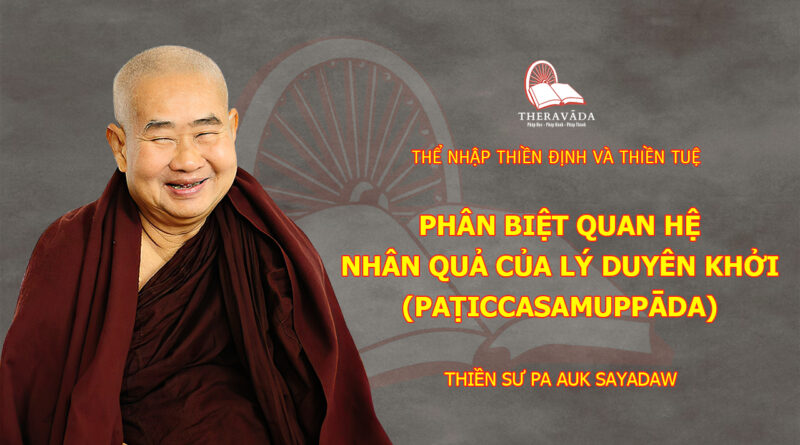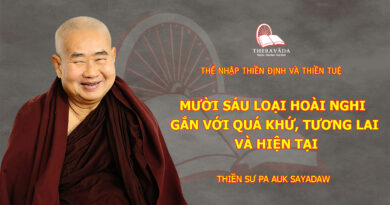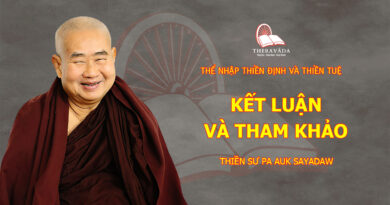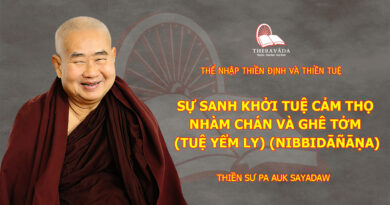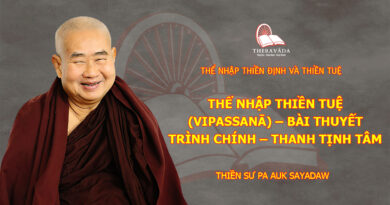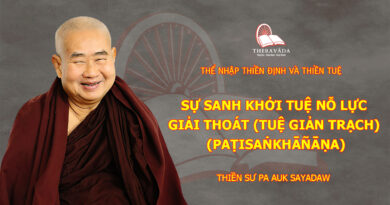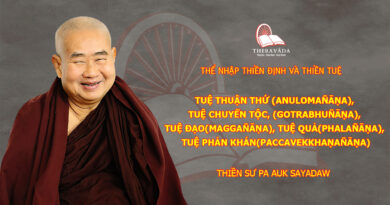Discerning the Causal Relations of Paṭiccasamuppāda
Phân Biệt Quan Hệ Nhân Quả Của Lý Duyên Khởi (Paṭiccasamuppāda)
To clarify these sixteen kinds of doubt, the meditator must discern vividly the cause-effect relations of Dependent Origination or Dependent Arising (Paṭiccasamuppāda). The Buddha has reminded Ānanda that beings have to undergo the round of rebirths life after life because they do not understand properly and penetratively the causal relations of Dependent Arising.
129Để làm sáng tỏ mười sáu loại hoài nghi này, hành giả phải phân biệt một cách sâu sắc quan hệ nhân-quả của Lý Duyên Khởi hay Y Tương Sinh (Paṭiccasamuppāda). Đức Phật nhắc nhở ngài Ānanda rằng chúng sanh trải qua các vòng luân hồi, hết kiếp này đến kiếp khác bởi vì họ không hiểu biết đúng đắn và thấu suốt quan hệ nhân quả của Lý Duyên Khởi.
130Aso in Visuddhi Magga131 and Abhidhamma Commentary132 it is clearly stated thus: “There is no one, even in a dream, who has emancipated from the round of misery without the ability to break through the Paṭiccasamuppāda causal relations of the saṁsāra machine with his wisdom sword which has been sharpened on the sacred whetstone of concentration.
”Cũng vậy, trong Thanh Tịnh Đạo (Visuddhi Magga133) và Chú giải Vi Diệu Pháp(Abhidhamma134), điều đó được chỉ rõ là: “Không một ai, dù là trong giấc mơ, thoát ra khỏi vòng luân hồi khổ sở, trừ phi người ấy với thanh gươm tuệ được khéo mài trên đá định cao thượng, chặt đứt cỗ xe luân hồi(saṁsāra) mà lại không có năng lực thấu suốt quan hệ nhân quả theo Lý Duyên Khởi(Paṭiccasamuppāda) của cỗ xe luân hồi”.
Thus the causal relations of paṭiccasamuppāda must be discerned and verified by insight wisdom to clarify all doubts and straighten all wrong views. According to the instructions given in the Visuddhi Commentry:135
Như vậy, quan hệ nhân quả của Lý Duyên Khởi (Paṭiccasamuppāda) phải được phân biệt và xác minh bằng tuệ minh sát để làm sáng tỏ tất cả các hoài nghi và làm thẳng lại tất cả các tà kiến. Theo chỉ dẫn được đưa ra trong Chú giải Thanh Tịnh Đạo (Visuddhi Magga136):(1)
The past five causes – viz., ignorance (avijjā), kamma-formations (saṅkhāra), craving (taṇhā), grasping (upādāna), and kamma (kamma-bhava) – must be investigated and discerned first, and the arising of the present five effects – viz., resultant consciousness (viññāṇa), mentality-materiality (nāma-rūpa), six sense-bases (saḷāyatana), contact (phassa) and feeling (vedanā) – due to the five past causes must be observed clearly with wisdom by insight meditation.(1)
Năm nhân quá khứ – tức là, vô minh(avijjā), hành nghiệp (saṅkhāra), tham ái(taṇhā), chấp thủ (upādāna) và nghiệp hữu(kamma-bhava) – phải được thẩm sát và phân biệt trước tiên, và sự phát sanh năm quả hiện tại – tức là, thức quả (viññāṇa), danh-sắc(nāma-rūpa), lục nhập (saḷāyatana), xúc(phassa) và thọ (vedanā) – do năm nhân quá khứ phải được quan sát rõ ràng bằng trí tuệ của thiền minh sát.(2)
The present five causes – viz., ignorance, craving, grasping, kamma-formations and kamma must be discerned next and the arising of the future five effects – viz., resultant consciousness, mentality-materiality, six sense-bases, contact and feeling due to the present five causes must be observed clearly with wisdom by insight meditation. Herein the causes constitute the truth of the cause of suffering (samudaya-sacca) and the effects constitute the truth of suffering (dukkha-sacca).(2)
Năm nhân hiện tại – tức là, vô minh, tham ái, chấp thủ, hành nghiệp, và nghiệp hữu phải được phân biệt tiếp theo và sự phát sanh năm quả tương lai – tức là, thức quả, danh-sắc, lục nhập, xúc và thọ – do năm nhân hiện tại phải được quan sát rõ ràng bằng trí tuệ của thiền minh sát. Ở đây các nhân tạo thành chân lý về nguyên nhân của khổ (samudaya-sacca) và các quả tạo thành chân lý về khổ(dukkha-sacca).
Therefore the meditator must observe with wisdomDo vậy, hành giả phải quan sát với trí tuệ(1) the arising of the present dukkha sacca due to the past samudaya sacca,
(1) sự sanh của chân lý về khổ (dukkha sacca) ở hiện tại bởi chân lý về nguyên nhân của khổ (samudaya sacca) ở quá khứ,(2) the arising of the future dukkha sacca due to the present samudaya sacca.(2) sự sanh của chân lý về khổ (dukkha sacca) ở tương lai bởi chân lý về nguyên nhân của khổ (samudaya sacca) ở hiện tại.
To achieve this goal, the meditator, who could discern the arising and dissolving of mentality-materiality both internally and externally, develops the right concentration and observes his mentality-materiality in detail while he is offering food to a Buddha statue. Then he goes to the meditation hall, observes the arising and dissolving of mentality-materiality and traces the mentality-materiality backwards until he can discern the arising and dissolving of mentality-materiality while he was offering food to the Buddha. If he can see the mentality-materiality as he has seen while offering food to the Buddha, then he can discern the near past mentality-materiality.
Để thành tựu mục tiêu này, hành giả, là người có thể phân biệt sự sanh và diệt của danh-sắc cả bên trong lẫn bên ngoài, phát triển chánh định và quan sát chi tiết danh-sắc của mình trong khi đang cúng dường vật thực đến tượng Phật. Rồi hành giả đi đến thiền đường, quan sát sự sanh và diệt của danh-sắc và truy ngược lại đến khi có thể phân biệt sự sanh và diệt của danh-sắc khi đang cúng dường vật thực đến tượng Phật. Nếu hành giả có thể thấy danh-sắc như đã thấy khi cúng dường vật thực đến Đức Phật, lúc đó hành giả có thể phân biệt danh-sắc ở quá khứ gần.
After that, he can go on tracing the series of mentality-materiality backward to observe the arising and dissloving of mentality-materiality in himself during prominent instances that took place yesterday, two days ago, — a week ago, two weeks ago, — a month ago, two months ago, — a year ago, two years ago, — until he can discern the mentality-materiality at the time of conception in his mother’s womb.
Sau đó, hành giả có thể tiếp tục truy ngược lại chuỗi danh-sắc để quan sát sự sanh và diệt của danh-sắc của chính mình trong các sự việc nổi bật diễn ra ngày hôm qua, hai ngày trước đó, – một tuần trước, hai tuần trước, – một tháng trước hai tháng trước, – một năm trước, hai năm trước, – đến khi có thể phân biệt được danh-sắc vào lúc thụ thai trong bụng mẹ của mình.
So now he knows the present five effects pertaining to the present existence: rebirth consciousness and the associated mental factors, kammaja rūpas and the sense bases, the contact of the sense base with the sense object and the resultant feeling.
Như vậy, bây giờ, hành giả biết năm quả hiện tại gắn liền với sự hiện hữu hiện tại: tâm tục sanh (kiết sanh thức) và các tâm sở phối hợp, các sắc do nghiệp sanh (kammaja rūpa) và lục nhập, xúc của căn với cảnh và thọ quả.
Then he goes on tracing the series of mentality-materiality backward in the immediate past existence. He can actually observe his past existence, the important events and the actions done in that existence. Then he focuses his mind on the mentality-materiality that arises at the time of near death when the maranasanna nimitta was appearing. From this nimitta he discerns the kamma-formations and the kamma that condition the arising of the present existence. He can also discern the three supporting forces, that is, ignorance, craving and gasping, from the accompanying consciousness. Next he tries to discern whether these past five causes gave rise to the present five effects. He can see the arising of the five effects due to the five causes if they represent the true cause-effect relation.
Sau đó, hành giả tiếp tục truy ngược lại chuỗi danh sắc đến ngay kiếp sống trước. Hành giả có thể thật sự quan sát kiếp quá khứ của mình, các sự kiện quan trọng và các hành động đã làm trong kiếp sống đó. Sau đó, hành giả tập trung tâm mình trên danh-sắc khởi sanh lúc sắp lâm chung khi tướng cận tử (maraṇāsanna nimitta) đang xuất hiện. Từ tướng này, hành giả phân biệt các hành nghiệp và nghiệp làm duyên cho sự phát sanh kiếp sống hiện tại. Hành giả cũng có thể phân biệt ba lực hỗ trợ, đó là, vô minh, tham ái và chấp thủ, từ tâm đi cùng. Tiếp theo, hành giả cố gắng phân biệt năm nhân quá khứ có sanh ra năm quả hiện tại hay không. Hành giả có thể thấy sự sanh của năm quả do năm nhân nếu chúng thực sự thể hiện quan hệ nhân quả.
Then he traces the series of mentality-materiality backward in his past existence until he discerns the rebirth consciousness, the associated mental factors, the kammaja rūpas, the sense bases, the contact of the sense base with the sense object and the resultant feeling. He then proceeds tracing the series of mentality-materiality backward in his second past existence in order to find the five causes in that existence that give rise to the five effects in the first past existence. If he is successful, he can proceed to find the cause-effect relation of the third past existence and the second past existence.
Sau đó, hành giả truy ngược lại chuỗi danh sắc trong kiếp quá khứ của mình đến khi phân biệt được tâm tục sanh, các tâm sở phối hợp, các sắc do nghiệp sanh (kammaja rūpa), lục nhập, xúc của căn với cảnh và thọ quả. Rồi hành giả tiến lên truy ngược lại chuỗi danh-sắc ngược đến kiếp sống quá khứ thứ hai để tìm thấy năm nhân trong kiếp sống đó gây ra năm quả ở kiếp sống quá khứ thứ nhất. Nếu hành giả thành công, hành giả có thể tiến đến tìm kiếm quan hệ nhân quả của kiếp sống quá khứ thứ ba và kiếp quá khứ thứ hai.
He must also discern the cause-effect relation of the present existence with the future existence. So he offers food to the Buddha again, making a wish what he wants to be in the next existence. If he wishes to become a celestial being, then thinking the celestial existence to really exist is ignorance, the desire to become a celestial being is craving, and clinging to that desire is grasping (upādāna). His wholesome consciousness and volition for offering food to the Buddha are kamma-formations, and the kamma seed deposited in his mental and material stream is kamma-bhava. So now he has developed the five causes for conditioning a new existence to arise.
Hành giả cũng phải phân biệt quan hệ nhân quả của kiếp hiện tại này với kiếp tương lai. Như vậy, hành giả lại cúng dường vật thực đến Đức Phật, thực hiện một ước nguyện về những gì mình muốn ở kiếp sống tiếp theo. Nếu hành giả nguyện ước trở thành một thiên nhân, lúc đó suy nghĩ rằng kiếp thiên nhân thực sự có tồn tại là vô minh, nguyện ước trở thành một thiên nhân là tham ái và chấp thủ vào ước nguyện đó là chấp thủ (upādāna). Thiện tâm của hành giả và ý muốn cúng dường vật thực đến Đức Phật là hành nghiệp, và hạt giống nghiệp (kamma) đã gieo trong dòng danh và sắc của hành giả là nghiệp hữu (kamma-bhava). Như vậy, bây giờ, hành giả đã gieo năm nhân làm duyên cho kiếp sống mới sanh ra.
Then he intently tries to observe the new existence that will arise due to the five present causes. Usually he observes a new existence which may or may not be the existence that he wished for. Anyhow, he discerns the rebirth consciousness, the associated mental factors, the kammaja rūpas and sense bases, the contact of the sense base and the sense object and the resultant feeling at the time of rebirth of the new existence. He tries to discern whether the present five causes give rise to the future five effects. If they are the true cause-effect relation, he can observe the arising of the five future effects due to the present five causes. He continues to discern the cause-effect relation of the first future existence and the second future existence in a similar way, and so on until he can observe no more future existence.
Sau đó, hành giả cố gắng chăm chú quan sát kiếp sống mới sẽ sanh ra vì năm nhân hiện tại. Thông thường, hành giả quan sát một kiếp sống mới mà có thể là hoặc không là kiếp sống mà hành giả ước nguyện. Dù sao đi nữa, hành giả phân biệt tâm tục sanh và các tâm sở phối hợp, sắc do nghiệp sanh(kammaja-rūpa) và lục nhập, xúc của căn với cảnh và thọ quả vào lúc tái sanh kiếp sống mới. Hành giả cố gắng phân biệt xem năm nhân hiện tại có sanh ra năm quả ở tương lai hay không. Nếu chúng thật sự là quan hệ nhân quả, hành giả có thể quan sát sự sanh của năm quả tương lai vì năm nhân hiện tại. Hành giả tiếp tục phân biệt quan hệ nhân quả của kiếp tương lai thứ nhất và kiếp tương lai thứ hai theo cách tương tự, và cứ thế tiếp tục đến khi hành giả quan sát thấy rằng không còn kiếp tương lai nào nữa.
So now he has successfully discerned the Paṭiccasamuppāda causal relations of his three past existences, the present existence and the future existences in terms of five causes and five effects:Như vậy, bây giờ, hành giả đã phân biệt thành công quan hệ nhân quả của Lý Duyên Khởi (Paṭiccasamuppāda) ở ba thời là các kiếp quá khứ, kiếp hiện tại, các kiếp tương lai theo nghĩa năm nhân và năm quả:
“Five causes were there in the past; “Năm nhân có trong đời quá khứ;
Five fruits we find in the present life; Năm quả chúng ta tìm thấy trong đời hiện tại;
Five causes do we now produce, Năm nhân chúng ta đang tạo ra bây giờ;
Five fruits we reap in future life.“137 Năm quả chúng ta sẽ gặt hái ở đời tương lai.”138
He further discerns the Paṭiccasamuppāda causal relations from one existence to another in terms of one cause and one effect as
Hành giả phân biệt xa hơn nữa quan hệ nhân quả của Lý Duyên Khởi (Paṭiccasamuppāda) từ kiếp sống này đến kiếp sống khác theo nghĩa một nhân và một quả là(1)
dependent on ignorance (avijjā) arise kamma formations (saṅkhāra);
(1) do duyên vô minh (avijjā), hành nghiệp(saṅkhāra) sanh;(2)
dependent on kamma formations arises the resultant consciousness (viññāṇa);
(2) do duyên hành nghiệp, thức quả (viññāṇa) sanh;(3)
dependent on the resultant consciousness arise associated cetasikas (nāma) and kammaja- rūpa;(3)
do duyên thức quả, các tâm sở (cetasika) (danh – nāma) phối hợp và sắc do nghiệp sanh (kammaja-rūpa) sanh;(4)
dependent on mentality-materiality (nāma-rūpa) arise six internal bases (saḷāyatana);(4)
do duyên danh-sắc (nāma-rūpa), lục nhập(saḷāyatana) sanh;(5)
dependent on six internal bases arises contact (phassa) with sense objects;(5)
do duyên lục nhập, xúc (phassa) với cảnh sanh;(6)
dependent on contact arises feeling (vedanā);(6)
do duyên xúc, thọ (vedanā) sanh;(7)
dependent on feeling arises craving (taṇhā);(7)
do duyên thọ, tham ái (taṇhā) sanh;(8)
dependent on craving arises grasping or clinging (upādāna)(8)
do duyên tham ái, chấp thủ (upādāna) sanh;(9)
dependent on grasping arises kamma formations (kamma-bhava) and rebirth process (upapatti-bhava);(9)
do duyên thủ, nghiệp hữu (kamma-bhava) và sanh hữu (upapatti-bhava) sanh;(10)
dependent on kamma formations (in the present existence) arises birth (jāti) (in the future existence);(10)
do duyên nghiệp hữu (trong kiếp hiện tại) sanh (jāti) (trong kiếp tương lai) sanh;(11)
dependent on birth arise decay-and-death (jarā-marana), worry (soka), lamentation (parideva), pain (dukkha), grief (domanassa) and despair (upāyāsa).139(11)
do duyên sanh, già-chết (jarā-marana), sầu (soka), bi (parideva), khổ (dukkha), ưu(domanassa) và ai oán (upāyāsa) sanh.140
After discerning clearly all the causal relations from the most past existence to the last future existence, he can observe the whole series of the arising and dissolving of mentality-materiality extending from the most past existence to the last future existence. So he can get rid of all the 16 doubts described earlier as well as the wrong views such as the ‘View of Uncausedness’ (Ahetuka-diṭṭhi), the ‘view of the Wrong Cause’ (Visama-hetuka-diṭṭhi), the ‘View of the Inefficacy of Action’ (Akiriya-diṭṭhi), the ‘View of Nihilism’ (Natthika-diṭṭhi), the ‘View of Eternity of the Soul’ (Sassata-diṭṭhi) and the ‘View of Annihilation of the Soul’ (Uccheda-diṭṭhi).
Sau khi phân biệt rõ ràng tất cả các quan hệ nhân quả từ kiếp sống quá khứ xa nhất đến kiếp sống tương lai cuối cùng, hành giả có thể quan sát toàn bộ chuỗi sanh và diệt của danh-sắc mở rộng từ kiếp quá khứ xa nhất đến kiếp tương lai cuối cùng. Như vậy, hành giả có thể thoát khỏi tất cả 16 hoài nghi đã được miêu tả trước đây cũng như các tà kiến như “Vô nhân kiến” (Ahetuka-diṭṭhi), “Tà kiến Đấng Tạo Hóa” (Visama-hetuka-diṭṭhi), “Vô hành kiến” (Akiriya-diṭṭhi), “Vô quả kiến” (Natthika-diṭṭhi), “Thường kiến” (sassata-diṭṭhi), và “Đoạn kiến” (Uccheda-diṭṭhi).

